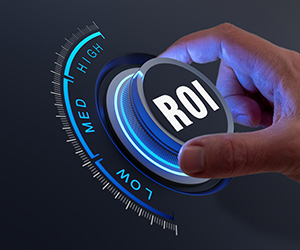Brand marketers are always under pressure to produce results from their promotional spending. But what exactly does that mean? Return on ad spend? Increased brand share? Building customer loyalty?
The pressure to deliver results is perhaps even greater for brands with tighter budgets, which must work harder to attract the attention of shoppers and the trade. Compounding this, misconceptions about what constitutes success and good strategy in growing a brand sometimes overshadow what really matters for building a brand for the long-term. Let’s examine some promotional marketing ‘myths’ that are sometimes mistakenly embraced.
Myth #1: ROI is measured only by immediate, measurable results.
 In today’s dashboard world, it’s easy get caught up in wanting to see real-time results vs. viewing the big picture. While marketers should embrace measuring everything, especially the direct attributable sales from programs but some things can’t be measured, at least not on the spot. For example, promotional activity should ideally be about introducing new customers to your brand to expand household penetration as a key first step to brand growth. However, those who learn about your brand through engaging messaging sometimes make decisions separately from the direct line of purchase influence we seek. Did you see a lift in sales on Amazon, even when it wasn’t the primary retail channel? Did an Amazon campaign lift brick and mortar retail sales as well?
In today’s dashboard world, it’s easy get caught up in wanting to see real-time results vs. viewing the big picture. While marketers should embrace measuring everything, especially the direct attributable sales from programs but some things can’t be measured, at least not on the spot. For example, promotional activity should ideally be about introducing new customers to your brand to expand household penetration as a key first step to brand growth. However, those who learn about your brand through engaging messaging sometimes make decisions separately from the direct line of purchase influence we seek. Did you see a lift in sales on Amazon, even when it wasn’t the primary retail channel? Did an Amazon campaign lift brick and mortar retail sales as well?
While a consumer might not purchase today, employing a consistent, integrated, promotional strategy aimed at the right target shoppers over time will serve to build solid sales momentum and gain retailer attention and support. In the end, creating and nurturing such connections to drive household penetration and customer lifetime value is what really matters and represents perhaps a truer measure of success.
Myth #2: Promotion means discounting.
 False. Yes, temporary price reductions, coupons, and rebates are part of what retailers expect from brands, and all consumers like a good deal. However, an over reliance on discounts to drive velocity often trains consumers to buy a brand strictly on price. Not to mention, it’s a strategy that any competitive brand can readily activate. Instead, it’s brands that spark engagement and add value to people’s lives through the relevance and fun of promotions that succeed in creating real brand loyalty over time.
False. Yes, temporary price reductions, coupons, and rebates are part of what retailers expect from brands, and all consumers like a good deal. However, an over reliance on discounts to drive velocity often trains consumers to buy a brand strictly on price. Not to mention, it’s a strategy that any competitive brand can readily activate. Instead, it’s brands that spark engagement and add value to people’s lives through the relevance and fun of promotions that succeed in creating real brand loyalty over time.
Providing an amazing recipe or the fun of entering a great contest/sweepstakes program is often a better way to engage consumers and turn them into brand shoppers. Certainly, discounts play a role in brand promotional strategy, but relevant promotional experiences are what consumers remember and cause them to connect with a brand.
Myth #3: Promotional marketing does not build brands.
 If ever there was a false choice, it’s between promotions and brand building. Targeted, consumer-driven promotions serve to build out the brand experience in ways that further engage consumers with the product. Promotions such as ‘Build a Better Burger’ demonstrated how a day-to-day wine like Sutter Home could complement every burger to provide a fun and more enjoyable dining experience. It’s the job of marketing to do a lot more than encourage a single purchase. Rather, marketers must work to form a relationship with consumers that lets them know the brand understands them, sparks relevant usage occasions, and provides a unique value that fits with their lifestyle. Promotions that creatively showcase how a brand fits into everyday life, position it as the solution (or ‘hero’), and establish what makes it unique are clearly the ties that bind.
If ever there was a false choice, it’s between promotions and brand building. Targeted, consumer-driven promotions serve to build out the brand experience in ways that further engage consumers with the product. Promotions such as ‘Build a Better Burger’ demonstrated how a day-to-day wine like Sutter Home could complement every burger to provide a fun and more enjoyable dining experience. It’s the job of marketing to do a lot more than encourage a single purchase. Rather, marketers must work to form a relationship with consumers that lets them know the brand understands them, sparks relevant usage occasions, and provides a unique value that fits with their lifestyle. Promotions that creatively showcase how a brand fits into everyday life, position it as the solution (or ‘hero’), and establish what makes it unique are clearly the ties that bind.
Myth #4: Build a DTC website and the consumer will come.
 Having a creative, consumer-centric DTC website is essential in today’s marketplace. However, without a sound media strategy behind it, a site will fail to reach its full potential regardless of how flawless it might be. Instead, brands must strategically work to drive traffic to their site through use of engaging, relevant approaches directed at their target customer. For example, active management and monitoring of a site’s SEO/SEM will help ensure that content on a website aligns with words/phrases online shoppers use when searching a category, resulting in elevation of a site within the ranks of searches and drawing more organic visitation as a result. Social media represents another resource that can help lure shoppers to a website, especially when the content of those social posts captures the brand experience on a functional and emotional level, encouraging shoppers to want to know more. And of course, simply having good website content can help elevate the likelihood that other digital players (i.e., reputable publications and bloggers) might reference a brand and website in their articles, creating a strong backlink profile for your brand. Even when we do everything right to drive traffic to our site, the shopper has a lot of options and is equally as likely to pursue the actual purchase on Amazon, Walmart.com and elsewhere where they regularly shop, both off and online. A rising tide floats more than your website engagement – it floats all e-commerce boats!
Having a creative, consumer-centric DTC website is essential in today’s marketplace. However, without a sound media strategy behind it, a site will fail to reach its full potential regardless of how flawless it might be. Instead, brands must strategically work to drive traffic to their site through use of engaging, relevant approaches directed at their target customer. For example, active management and monitoring of a site’s SEO/SEM will help ensure that content on a website aligns with words/phrases online shoppers use when searching a category, resulting in elevation of a site within the ranks of searches and drawing more organic visitation as a result. Social media represents another resource that can help lure shoppers to a website, especially when the content of those social posts captures the brand experience on a functional and emotional level, encouraging shoppers to want to know more. And of course, simply having good website content can help elevate the likelihood that other digital players (i.e., reputable publications and bloggers) might reference a brand and website in their articles, creating a strong backlink profile for your brand. Even when we do everything right to drive traffic to our site, the shopper has a lot of options and is equally as likely to pursue the actual purchase on Amazon, Walmart.com and elsewhere where they regularly shop, both off and online. A rising tide floats more than your website engagement – it floats all e-commerce boats!
It’s also important to recognize that DTC websites are not only selling platforms but also instruments of learning. Brands can offer items/product sizes that are uniquely available only through their DTC website for garnering consumer reaction and insight into those products before considering their release into the mass market. Brands can also leverage DTC websites to build customer email databases (via newsletter sign-ups and on-the-spot discounts) which can be used for remarketing purposes and to create even better content driven by how those database customers shop and navigate through the site. The point is that DTC websites, like any good asset, require on-going traffic, leads, and customers (TLC) to ensure they are delivering optimized performance and value for brands and consumers alike.
Myth #5: An agency always adds cost.
 No brand is an island, so having that agency point of view helps broaden the scope of understanding and solutions in the quest for better results. A good promotions-minded advertising agency adds value in ways that mitigate costly mistakes and make your working dollars (usually the biggest part of the budget) work harder to drive household penetration and customer life-time value. We do this through the perspective of continuously evaluating what works (and doesn’t!) across numerous promotions, campaigns, and media platforms, just like a client. An agency with true industry expertise can help make the right recommendations and manage each promotion as a step toward optimizing your marketing spend, scaling what works and growing the business with you.
No brand is an island, so having that agency point of view helps broaden the scope of understanding and solutions in the quest for better results. A good promotions-minded advertising agency adds value in ways that mitigate costly mistakes and make your working dollars (usually the biggest part of the budget) work harder to drive household penetration and customer life-time value. We do this through the perspective of continuously evaluating what works (and doesn’t!) across numerous promotions, campaigns, and media platforms, just like a client. An agency with true industry expertise can help make the right recommendations and manage each promotion as a step toward optimizing your marketing spend, scaling what works and growing the business with you.

